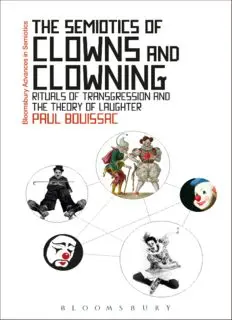
The Semiotics of Clowns and Clowning: Rituals of Transgression and the Theory of Laughter PDF
Preview The Semiotics of Clowns and Clowning: Rituals of Transgression and the Theory of Laughter
The Semiotics of Clowns and Clowning ADVANCES IN SEMIOTICS Semiotics has complemented linguistics by expanding its scope beyond the phoneme and the sentence to include texts and discourse, and their rhetorical, performative, and ideological functions. It has brought into focus the multimodality of human communication. Advances in Semiotics publishes original works in the field demonstrating robust scholarship, intellectual creativity, and clarity of exposition. These works apply semiotic approaches to linguistics and nonverbal productions, social institutions and discourses, embodied cognition and communication, and the new virtual realities that have been ushered in by the Internet. It also is inclusive of publications in relevant domains such as socio-semiotics, evolutionary semiotics, game theory, cultural and literary studies, human-computer interactions, and the challenging new dimensions of human networking afforded by social websites. Series Editor: Paul Bouissac is Professor Emeritus at the University of Toronto (Victoria College), Canada. He is a world-renowned figure in semiotics and a pioneer of circus studies. He runs the SemiotiX Bulletin (www.semioticon.com/semiotix), which has a global readership. Titles in the Series: A Buddhist Theory of Semiotics, Fabio Rambelli A Semiotics of Smiling, Marc Mehu Introduction to Peircean Visual Semiotics, Tony Jappy Semiotics of Drink and Drinking, Paul Manning Semiotics of Happiness, Ashley Frawley Semiotics of Religion, Robert Yelle The Language of War Monuments, David Machin and Gill Abousnnouga The Semiotics of Che Guevara, Maria-Carolina Cambre The Visual Language of Comics, Neil Cohn The Semiotics of Clowns and Clowning Rituals of Transgression and the Theory of Laughter PAUL BOUISSAC Bloomsbury Academic An imprint of Bloomsbury Publishing Plc LONDON • NEW DELHI • NEW YORK • SYDNEY Bloomsbury Academic An imprint of Bloomsbury Publishing Plc 50 Bedford Square 1385 Broadway London New York WC1B 3DP NY 10018 UK USA www.bloomsbury.com BLOOMSBURY and the Diana logo are trademarks of Bloomsbury Publishing Plc First published 2015 © Paul Bouissac, 2015 Paul Bouissac has asserted his right under the Copyright, Designs and Patents Act, 1988, to be identified as Author of this work. All rights reserved. No part of this publication may be reproduced or transmitted in any form or by any means, electronic or mechanical, including photocopying, recording, or any information storage or retrieval system, without prior permission in writing from the publishers. No responsibility for loss caused to any individual or organization acting on or refraining from action as a result of the material in this publication can be accepted by Bloomsbury or the author. British Library Cataloguing-in-Publication Data A catalogue record for this book is available from the British Library. ISBN: HB: 978-1-4725-2173-6 PB: 978-1-4725-3278-7 ePDF: 978-1-4725-3111-7 ePub: 978-1-4725-2508-6 Library of Congress Cataloging-in-Publication Data Bouissac, Paul. The semiotics of clowns and clowing : rituals of transgression and the theory of laughter / Paul Bouissac. pages cm. – (Bloomsbury advances in semiotics) Includes bibliographical references and index. ISBN 978-1-4725-3278-7 (paperback) – ISBN 978-1-4725-2173-6 (hardback) – ISBN 978-1-4725-3111-7 (epdf) 1. Semiotics. 2. Performing arts–Semiotics. 3. Clowns–Semiotics. 4. Wit and humor. 5. Visual communication. 6. Modality (Linguistics) 7. Multimedia communications. I. Title. PN1590.S26B68 2015 791.3’3014 – dc23 2014037436 Series: Bloomsbury Advances in Semiotics Typeset by Integra Software Services Pvt. Ltd. This book is dedicated to the memory of Charlie Cairoli (1910–1980) and Pépète (Alfred) Pauwels (1912–1989), who embodied for me the legendary vis comica and often made me irresistibly laugh. Contents Introduction 1 1 The Faces of the Clown 19 Appearance and identity 19 The making of a face 21 Kinds and scales of facial transformations in clowns 23 The crafting of a clown’s makeup 25 The face of dominance 32 Interpreting the face of a clown 38 The modern face of the clown 42 When clowns go postmodern 46 2 The Costumes of the Clowns 49 The clowns’ trunks 49 The splendor and sophistication of the whiteface 50 The auguste’s misfits and tatters 53 The sociosemiotics and biosemiotics of clown costumes 55 Clowns in drag: Cross-dressing and transvestism 57 3 The Clown’s Workshop 61 The semiotics of artifacts 61 A visit to Charlie Cairoli’s workshop 63 When clowns play magic 69 Clowns as craftsmen and engineers 71 The clown’s barnyard 72 4 The Semiotics of Gags 75 What is a gag? 75 Gags in context 78 Rob Torres: A solo clown act in New York 85 The semiotic anatomy of gags 88 The physics of gags 95 viii CONTENTS 5 The Game of the Rules 107 The language of clowning 107 The straight, the tight, and the loose 109 Identity: One in two, two in one 114 6 Clown and Trickster 123 Master of tricks 123 Too good to be true 126 Transgression and consequences 127 Master of fire 129 The trickster and his avatars 132 Understanding tricksters and clowns 137 Peering into the cultural past: A reasoned speculation 139 7 Clowns and Gender Play: The Politics and Economics of Sex 143 Beyond sex and gender 143 Images of desire 144 An odd couple 146 A “normal” couple 149 A bird tale 153 Gender play 155 8 Clowns, Death, and Laughter 159 Death at the circus 159 Death of the auguste 163 Realm of the macabre: Ghosts, corpses, and skeletons 165 Clowns and death in the arts: Laughter at the edge 168 9 Profaning the Sacred: The Saga of the Clown 171 The avatars of Clown 171 A grand narrative and its fractal performances 173 The sacred and the profane 175 Putting things inside out and upside down 177 10 Clowns without Borders 181 Mapping clowns around the world 181 Clowns without borders? 182 Clowning beyond the cultural fences 185 Clowning in Java 188 The gentrification of clowning 195 Clowns with a mission 197 CONTENTS ix Conclusion: Contribution to the Theory of Laughter 201 What is laughter? 201 The meaning of laughter 203 Senseless laughing 205 Laughing as an addiction: A hypothesis and an agenda 207 References 213 Index 217
